As it may have been shown in some recent articles here in TFB, my browsing in old photo negatives files and notes has sometimes resulted in successfully unearthing material that proved to be of some interest for our readers, if the Comments that followed are to be believed. Well, in January, 1991, I was in Buenos Aires with son/photographer Felipe gathering material for articles when my great friend Pantaleón Kotelchuck, a weapons technician of Argentina’s Federal Police and top advisor of RENAR – Registro Nacional de Armas (National Guns Register), suggested a visit to a local company called Lasserre S.A. to take a look at some of its products, which were sold in the local market under the name Rexio. A couple of quick phone calls by the always-cooperative “Panta” were enough to take us to Avellaneda, one of the cities that form the Metropolitan area of the nation’s capital.

A bunch of Rexio Standard (a.k.a. Super Comanche, in the U.S.) pistols in the final assembly/inspection stage at the no-frills Lasserre S.A. facilities in Avellaneda, Buenos Aires Province.

Double-barrel Rexio Super 152 “pistolones” receiving final manufacture touches at the factory, with a number of foldable-stock “armas de supervivencia” in the foreground.
With relatively small, modest facilities and pretty simple machines and tools installed in a single, equally, small-sized production building, the concern was specialized in making break-action, single-shot “Pistolones” (Big Pistols), both in single- and double-barrel configurations, plus a two-caliber “arma de supervivencia”, or survival gun, with a metal folding stock. Now, over a quarter of a century later, I tried to find my old, hand-written notes on the said visit and guns involved, but with no results. They must have been lost during one of my several home-moving activities in this time frame, so what follows will be based on memory (uh!) only, plus a couple of things found online. And our own photos, of course.

The (somewhat?) elegant, single-barrel Rexio Standard, known as the Super Comanche in the U.S. market, was the first basic .410 pistol produced in quantity by the Argentine company.

The same example with the 250mm barrel in the loading/extraction position, the .410 (or 36-caliber, in the local jargon) shotshell shown being an Orbea brand, also made in Argentina.
First of all, one may wonder why the heck someone may want or need a one-shot handgun in such a puny caliber. Also first, I’d say it’s a way of giving you the basic fun of owning and shooting a firearm, plain as that. Then, it may prove handy for small game (e.g. rabbits, partridges, etc.) hunting, pest control, and anti-snake use, as common examples. For home or personal defense? Well, sometimes you may not have any gun at hand, and some gun is definitely better than no gun, at all. And a .410 shell fired from a short-barrel gun is very noisy! Add to that: a break-barrel pistol is simple to operate by most untrained hands, can cause a lot of pain on the recipient’s side, man or beast, and barely needs any aiming at the very close ranges it is generally expected to be employed. Oh, yes: in the case of the Argie pistol, it was almost as cheap as dirt! And this counts much in this neck of the woods, too.
The basic Rexio Standard model was fitted with a 250mm barrel, which gave it an overall length of 350mm. Weight was 1,3kg. To keep manufacture costs low, the gun frame was made of Zamac alloy, which generally combines zinc with elements of aluminum, magnesium and copper in variable compositions. That’s not a good option when it comes to general material strength, and I’ve heard stories of broken Rexio pistol frames, but not really of any kaboom events. The gun also came with an option to fire .45 Colt (the so-called Long Colt) cartridges in addition to the 2/12 and 3in .410 shells.
Firing the gun is as straightforward as possible. Press forward the catch just ahead of the trigger guard to unlock the barrel from position and open the breech for ammo loading. Cock the huge hammer, take aim (in my gun, just a small bead-type front sight) and press the trigger. As expected, opening the gun again will extract the fired cartridge from the chamber for manual removal. That’s it.

Author opening the barrel prior to chambering a round and preparing to fire the Rexio Standard at the gun’s factory grounds in Avellaneda, Buenos Aires Province, in January, 1991. He also fired the pistol using the underbarrel plastic extension as a support grip, a convenient option. (Both photos by Felipe Olive)
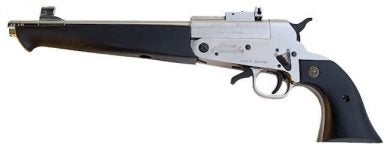
This adjustable sights-fitted model is the Super Comanche in .22 Magnum for the U.S. market. Lever above trigger was an applied safety that kept the hammer from being cocked.
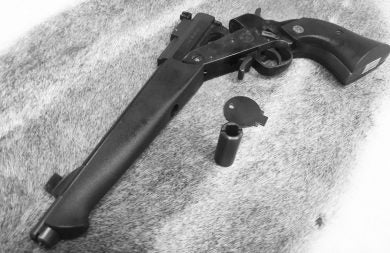
Shown in photo is one of the two muzzle adaptors, together with the disc-shaped key, that could alternate the gun to fire either .410 or .45 Colt ammo.

A shorter (150mm) barrel model was also made available for the U.S. market as the Compact Super Comanche. Some time later – after my visit, anyway – production guns dropped the Zamac alloy and reportedly used steel.
The company also produced a two barrel (over/under) gun with the same caliber options called the Rexio Super, with a more modern configuration, the grip/trigger guard giving a first-look impression of a semi-auto pistol. I believe that the barrels were also 250mm in length, but could not find my original notes on the gun for additional size and weight data. But I remember well how fun it was to shoot it.

The Rexio Super could also be configured to fire .410 and .45 Colt rounds, being, at least, intimidating for a last-ditch, self-defense, very-close-encounter situation.
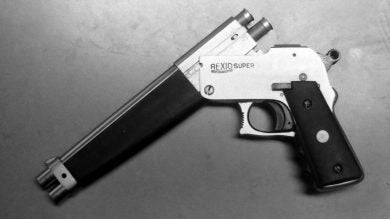
The gun with the barrel open and with two .410 shells partly in the chamber.
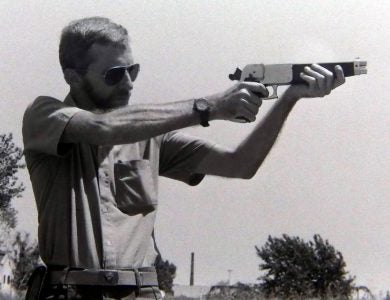
The support hand holding the synthetic handguard was almost an automatic reaction when preparing to fire the Super pistol. Shape of the cocked hammer is clear in picture. (Photo by Felipe Olive)

At the time of my visit to the factory, I was told that most local users tended to feed their Rexio “pistolones” with .410 rifled slugs rather than birdshot for defensive purpose. Since I’ve read somewhere (but not tested myself) that those slugs have a muzzle energy equivalent to a .45 ACP, I can understand the choice. I fired some Orbea slugs on an aluminum sheet (thickness unrecorded) at 3 or so meters, with the results shown in photo.

This supposedly-designated Rexio Modelo Super 250-M was a later-introduced modification with a vertical fore grip, but it is not known whether it was, in fact, produced in any quantity.
Get the Rexio Super, give it a couple of short, 152mm barrels, and viola, you have created the compact Rexio Super 152! Here it is:

The two Rexio Super “pistolones” in production back in 1991. No doubt they still look “aggressive” (or “defensive”?) in photo, maybe giving a potential thug some second thoughts…

No, it’s not a large frame semi-auto pistol, just the Rexio Super 152 loaded with a couple of .410 rifled slugs. “Stay away, ruffian!” (Photo by Felipe Olive)

A recent photo of a Rexio Super 152 pistol. (Image courtesy of Oyoy Kanamox)

This particular example ended up in Military Police hands in Foz do Iguaçu, Paraná State, Brazil, three years ago. Part of the trigger guard was missing (Zamac alloy?).
Now, get a Rexio Super pistol, give it a couple of much longer (400mm, or so) barrels and a foldable metal stock, and you’ve got an “arma de supervivencia” (survival gun). The guys in Buenos Aires, in fact, came out with an old M6 USAF Air Crew Survival Weapon-inspired gun with an over/under (.22LR/.410) barrel configuration, but which could also be supplied in a .410-only configuration. As far as I know, production somehow was very limited, so I was lucky enough to have laid my hands on and actually fired this weapon. Gracias, amigos!

That’s it: how a Rexio “pistolón” turned into an “arma de superviviencia” by the hands of the Lasserre S.A. company.

Blue and satin nickel examples of the long-barrel Argentine “pistolón”. Gun on top is a .22LR/.410 combo.

Muzzles of a .410-only model and a combination (.22LR/.410) variant.



The stock-folding sequence for the Rexio gun. (Photos by Felipe Olive)
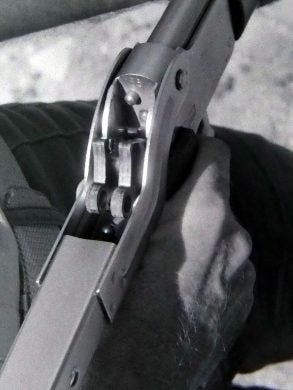
The two hammers are seen here in the cocked position, the left one firing the upper barrel and the right one, the lower. (Photo by Felipe Olive)

Being a single-trigger weapon, selection of barrel to be fired was with the sideways movement of a button above the pistol grip: to the right, lower barrel; to the left, upper barrel. Or the other way around. Twenty-six years later, I just can’t remember! (Photo by Felipe Olive)

I wouldn’t mind at all having just that Rexio gun at hand in a, well, urban survival situation. As mentioned in one of the opening paragraphs, “some” gun is better than “no” gun, at all. (Photo by Felipe Olive)

“Hasta la vista, baby!” (Photo by Felipe Olive)
 Your Privacy Choices
Your Privacy Choices
